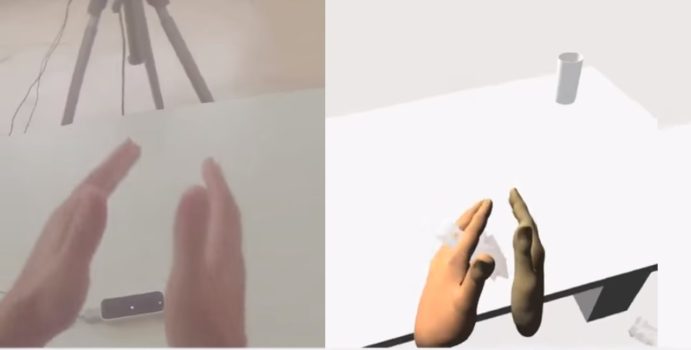
Alkonost Development, a London-based independent research and development start-up mostly focused on virtual reality and augmented reality, has launched the beta version of Extended Workspace, a virtual reality interface that allows users to use hand-tracking systems to interact with virtual environments with the entire hand — including fingers and fingertips – such that it is possible to rip, bend, fold materials in virtual reality.
The system simulates the actual and realistic interactions that users have with real world objects such as paper, wood, metals and stones in real world, in a way that there is more realistic and detailed virtual material experience that simply allowing gestures and use of generic clay like materials as is in previous systems such as Leap Motion and Razer Hydra.
The company, which seeks to develop a platform that allows better virtual experiences with objects in a manner not currently afforded by other platforms such as real time folding of papers with hands, shaping of wood, molding of clay, and curving, will target the interests of sculptors, product designers and architects. Rudolf Bogart, CEO and Founder of Alkonost Development told Hypergrid Business that there is already a lot of interest among architects as well as application potential in hand-tracking software developments and platforms looking for custom interfaces.
“So imagine that you can 3D scan a can of soda, upload it in Extended Workspace and finally crush it with your hands, that’s our goal,” said Bogart. “But also imagine that you can upload a cubic meter of wood and then sculpt it with your hands, imagine then that the wood would react like an actual cubic meter of wood.”
See demo video below:
The company used Oculus DK2, Leap Motion, and Kinect hardware on the Unreal engine to build the system, and will look to building custom interfaces for other applications. Currently, they are also looking at supporting hand-tracking software developments, applications, and hardware such as ManusVR, and see a future in Microsoft Hololens. They will also look into optimizing the graphics processing unit so that the Extended Workspace system can be able to function as a stand alone system.
“Our goal is to develop a vast library of algorithms that simulate in a utmost realistic way the materials around us, like paper as shown in the demo but also wood, metals, stone etc that are interactive, can in real-time be shaped or formed manually in any way, but with ‘real world’ characteristics,” said Bogart.
After receiving an initial boost from last year’s grant, the company is looking for more investors interested in real-life material simulations and the sharing of algorithms in order to facilitate specific applications, said Bogart.
- OpenSim active users hit all-time-high for the holidays - December 15, 2023
- OpenSim user activity ramping up for the holidays - November 15, 2023
- OpenSim land area at a new high as grids prep for holidays - October 15, 2023
